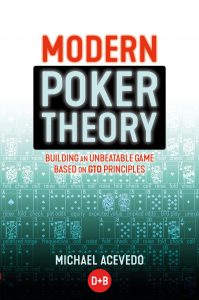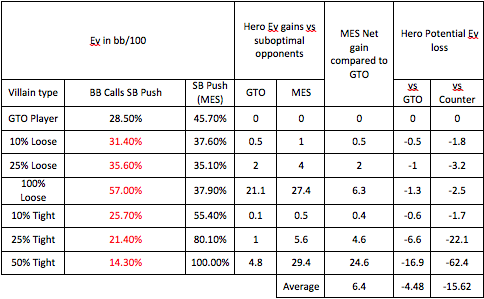 This post is a tiny piece of Michael Acevedo’s upcoming book Modern Poker Theory. I had the pleasure to see an early copy and it is excellent. You will not want to miss this ground-breaking book!
This post is a tiny piece of Michael Acevedo’s upcoming book Modern Poker Theory. I had the pleasure to see an early copy and it is excellent. You will not want to miss this ground-breaking book!
Passive Exploitation
Does GTO play make money against bad players?
In a HU situation, if one player is playing optimally vs a suboptimal opponent, any deviation the weaker player makes away from GTO to a worse strategy can only cost him value, which will in turn be gained by the optimal player. This phenomenon is called passive exploitation because the optimal player does not have to do anything besides play his equilibrium strategy to gain extra Ev from the suboptimal player.
Active Exploitation
Active exploitation happens whenever a player deviates from his core strategy to further take advantage of an opponent’s leak.
Maximally Exploitative Strategy (MES): As explained before, MES happens when a player chooses to deviate from equilibrium to a strategy that maximizes Ev vs a villain’s suboptimal strategy (Only possible if the villain isn’t playing Game Theory Optimal himself).
Example: Consider the following simplified poker situation: Game: HUSNG Players can only Push of Fold. HUNLH, blinds 0.5bb/1bb Effective Stacks = 15bb Preflop: Hero is in the SB. His GTO strategy is to push 45.7%.
Let’s imagine eight different types of villains hero might encounter in a heads-up match:
GTO Player: This player will call a 15bb SB push optimally with a 28.5% range.
10% Loose Player: This type of villain is a bit sticky and calls a 15bb SB push with a 31.4% range.
25% Loose Player: This type of villain is a bit stickier and calls a 15bb SB push with a 35.6% range.
100% Loose Player: This type of villain really hates folding and calls a 15bb SB push with a 57% range.
10% Tight Player: This type of villain is a tighter and calls a 15bb SB push with a 25.7% range.
25% Tight Player: This type of villain is a lot tighter and calls a 15bb SB push with a 21.4% range.
50% Tight Player: This type of villain is a massive nit and calls a 15bb SB push with a 14.3% range.
In the next table, we summarize the SB Ev gains of playing GTO and MES vs the various opponents, as well as Hero potential Ev loss if villain plays GTO instead of the suboptimal strategy, or counter exploits Hero.
As seen in the table, GTO play can’t lose or win extra Ev vs a GTO player, but it gains extra Ev vs suboptimal players depending on the degree of the leak. MES on average gains an extra 6.4bb/100 vs suboptimal players more than GTO, but doing so creates a leak in our game that can on average be counter exploited for -15.62 bb/100.
Even vs an extremely bad opponent who is calling 2x more often than he should, MES only captures 6.3bb/100 more than GTO and can be exploited back for -2.5bb/100. If villain is calling 50% tighter than he should, MES does very well, yielding 24.6bb/100 more than GTO, but can in turn be counter exploited by -62.4bb/100. Additionally, our strategy shift is incredibly extreme as we are now shoving 100% hands instead of 28%, so our exploitative adjustment can be easily spotted by an aware opponent.
MES involve a degree of risk because we are putting ourselves in a situation where our opponent could counter exploit our new strategy to an even larger margin than we were trying to exploit him in the first place if he figures out what we are doing. Also, if we are wrong about our assessment of villain’s play (which is certain to happen from time to time) and adjust incorrectly, we will be the ones deviating to a weaker strategy that will in turn lose us value, thus we must be very careful and have a high degree of certainty in our reads if we are going for maximum exploitation.
If you enjoyed this article, you can pre-order Modern Poker Theory now and the physical book or ebook will be sent to you as soon as it is published.
Thanks for reading! Be sure to check back next week for another educational blog post.


Awsome, I wish DNB could ship to Canada ! Run good everybody!